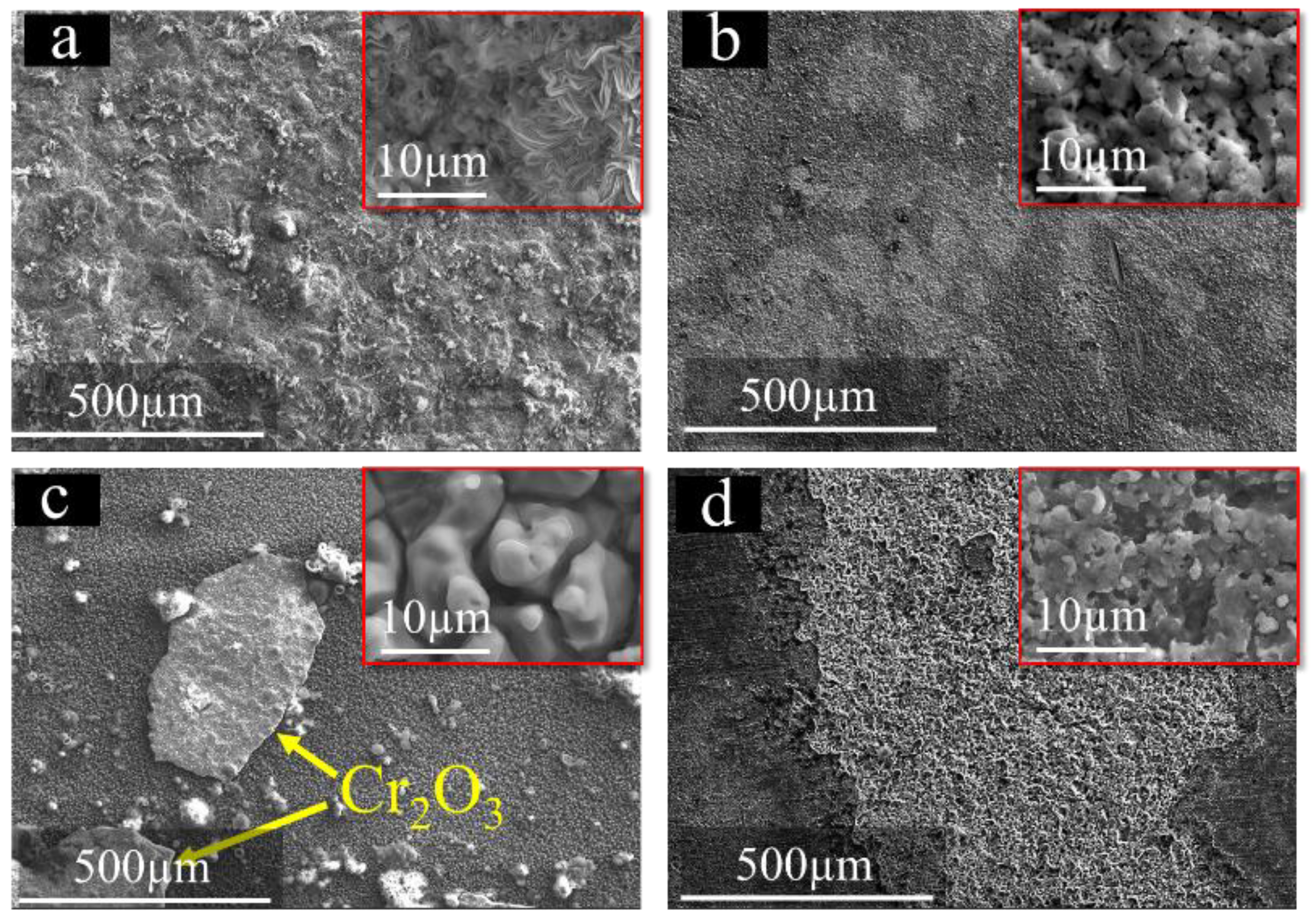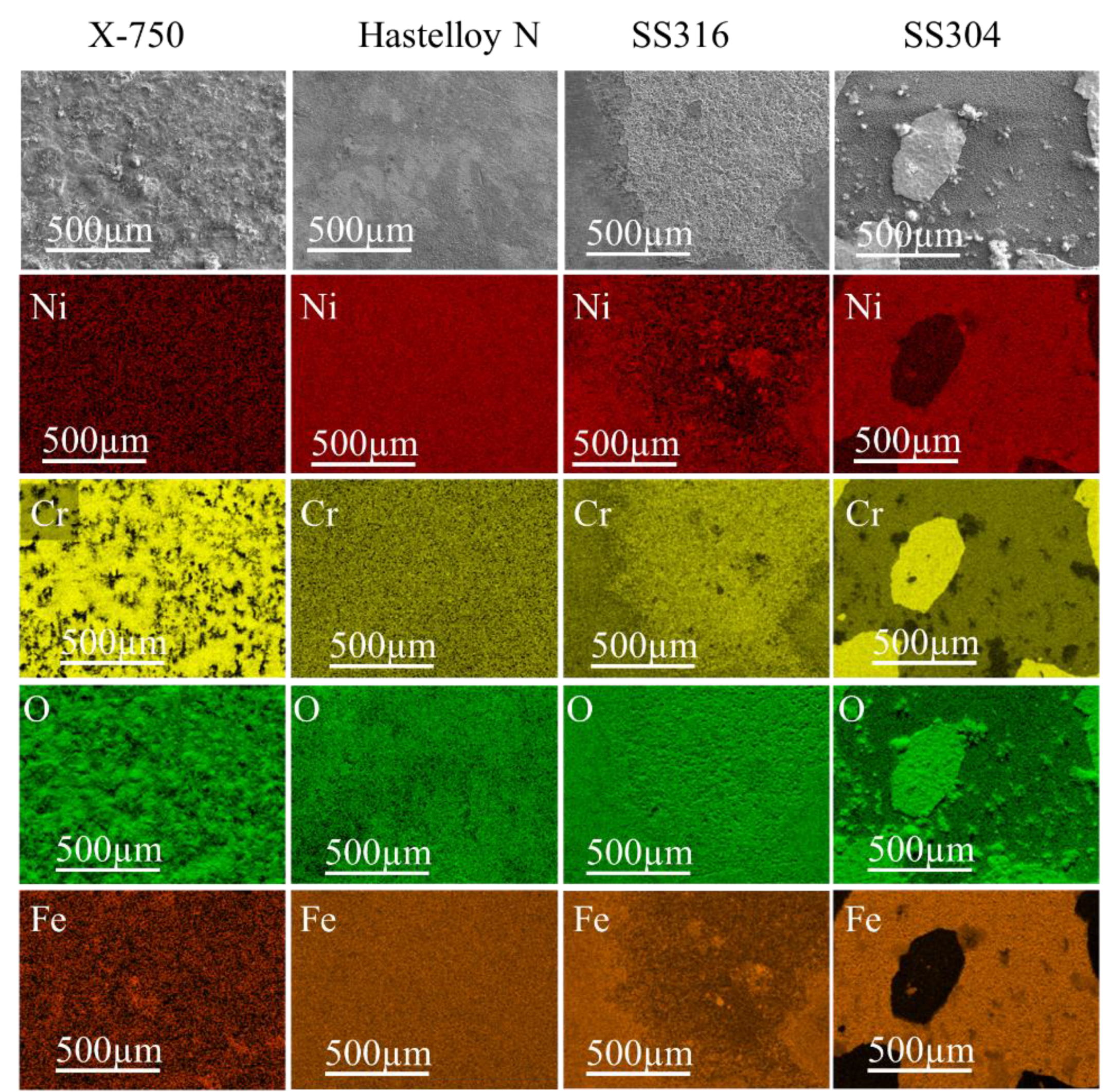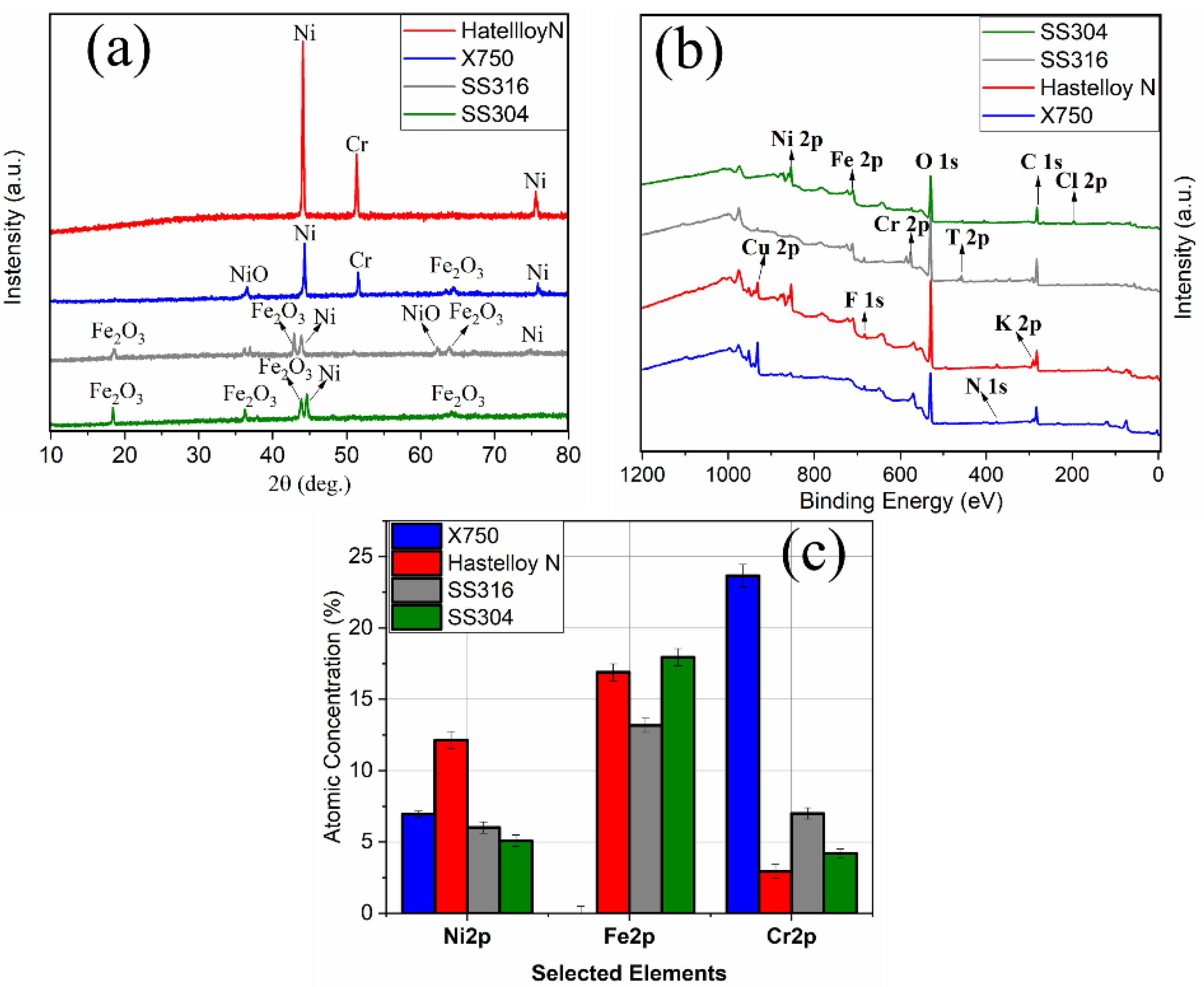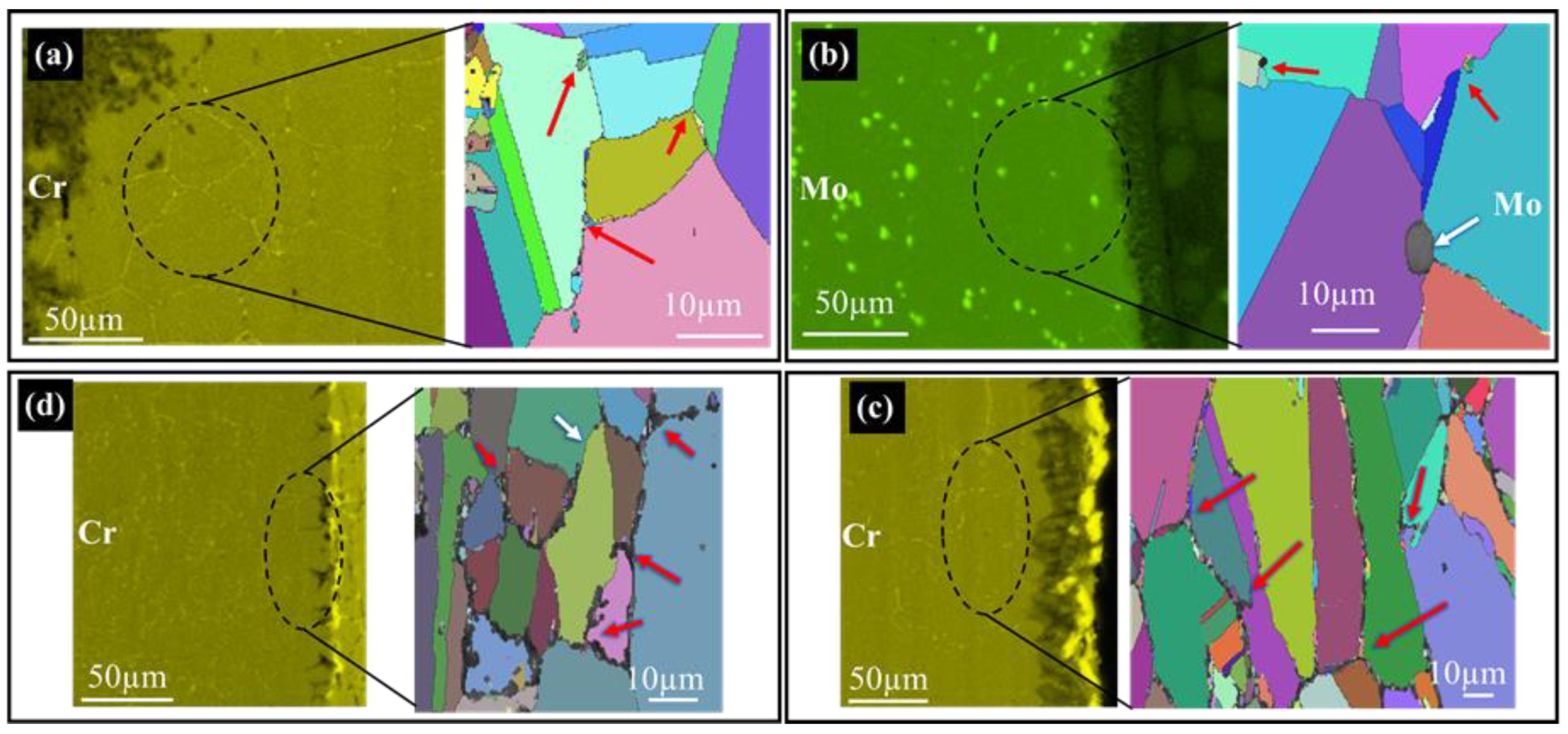Analysis of Corrosion of Hastelloy-N, Alloy X750, SS316 and SS304 in Molten Salt High-Temperature Environment
Abstract
1. Introduction
2. Materials and Methods
3. Results and Discussion
3.1. Weight Loss Measurements
3.2. Analysis of Surface Morphology after Molten Salt Corrosion Tests
3.3. XRD and XPS Analyses of Alloys after Corrosion
3.4. Microstructural Analysis of Corroded Alloys Using EBSD
4. Conclusions
Author Contributions
Funding
Institutional Review Board Statement
Informed Consent Statement
Data Availability Statement
Acknowledgments
Conflicts of Interest
References
- LeBlanc, D. Molten salt reactors: A new beginning for an old idea. Nucl. Eng. Des. 2010, 240, 1644–1656. [Google Scholar] [CrossRef]
- Haubenreich, P. Engel Experience with the Molten-Salt Reactor Experiment. Nucl. Appl. Technol. 1970, 8, 118–136. [Google Scholar] [CrossRef]
- He, X.; Song, J.; Tan, J.; Zhang, B.; Xia, H.; He, Z.; Zhou, X.; Zhao, M.; Liu, X.; Xu, L.; et al. SiC coating: An alternative for the protection of nuclear graphite from liquid fluoride salt. J. Nucl. Mater. 2014, 448, 1–3. [Google Scholar] [CrossRef]
- Seaborg Technologies Seaborg Wasteburner—Molten Salt Reactor; Seaborg: Copenhagen, Denmark, 2015; White Pap. 2015; SEAB-WP-2015-001.
- Generation IV International Forum (GIF) Annual Report; Atomic Energy Commision: Paris, France, 2014.
- Serrano-ópez, R.; Fradera, J.; Cuesta-López, S. Molten salts database for energy applications. Chem. Eng. Process. Process Intensif. 2013, 73, 87–102. [Google Scholar] [CrossRef]
- Sohal, M.S.; Ebner, M.A.; Sabharwall, P.; Sharpe, P. Engineering Database of Liquid Salt Thermophysical and Thermochemical Properties; INL/EXT-10-18297; Idaho Natl. Lab.: Idaho Falls, ID, USA, 2010. [Google Scholar] [CrossRef]
- Guo, S.; Zhang, J.; Wu, W.; Zhou, W. Corrosion in the molten fluoride and chloride salts and materials development for nuclear applications. Prog. Mater. Sci. 2018, 97, 448–487. [Google Scholar] [CrossRef]
- Ignatiev, V.; Surenkov, A. Material Performance in Molten Salts. In Comprehensive Nuclear Materials; Elsevier: Moscow, Russia, 2012; Volume 5, pp. 221–250. ISBN 9780080560335. [Google Scholar]
- Koger, J.W. Fluoride Salt Corrosion and Mass Transfer in High Temperature Dynamic Systems. Corrosion 1973, 29, 115–122. [Google Scholar] [CrossRef]
- Ouyang, F.Y.; Chang, C.H.; Kai, J.J. Long-term corrosion behaviors of Hastelloy-N and Hastelloy-B3 in moisture-containing molten FLiNaK salt environments. J. Nucl. Mater. 2014, 446, 81–89. [Google Scholar] [CrossRef]
- DeVan, J.H.; Evans, R.B., III. Corrosion Behavior of Reactor Materials in Fluoride Salt Mixtures; U.S. Atomic Energy Commision: Oak Ridge, TN, USA, 1962. [Google Scholar]
- Ignat’ev, V.V.; Surenkov, A.I.; Gnidoi, I.P.; Fedulov, V.I.; Uglov, V.S.; Panov, A.V.; Sagaradze, V.V.; Subbotin, V.G.; Toropov, A.D.; Afonichkin, V.K.; et al. Investigation of the corrosion resistance of nickel-based alloys in fluoride melts. At. Energy 2006, 101, 730–738. [Google Scholar] [CrossRef]
- Sellers, R.S.; Anderson, M.H.; Sridharan, K.; Allen, T.R. Failure analysis of 316L stainless steel crucible by molten fluoride salt interaction with clay bonded silicon carbide. Eng. Fail. Anal. 2014, 42, 38–44. [Google Scholar] [CrossRef]
- Salma, P.; Marecek, M. Corrosion testing of nickel alloy for molten salt reactors. J. Achiev. Mater. Manuf. Eng. 2015, 70, 78–85. [Google Scholar]
- Liu, T.; Dong, J.; Xie, G.; Wang, Y.; Li, H.; Li, Z.; Zhou, X.; Lou, L. Corrosion behavior of GH3535 superalloy in FLiNaK molten salt. Jinshu Xuebao/Acta Metall. Sin. 2015, 51, 1059–1066. [Google Scholar] [CrossRef]








| C | Si | Mn | Ni | Cr | Mo | Cu | Fe | Nb + Ta | |
|---|---|---|---|---|---|---|---|---|---|
| X750 | 0.08 | 0.5 | 1 | Balance | 17 | - | 0.5 | 5 | 1.2 |
| Hatelloy-N | 0.06 | 1 | 0.8 | Balance | 7 | 16 | 4 | - | |
| SS316 | 0.024 | 0.60 | 0.98 | 10.13 | 16.77 | 2.02 | 0.10 | Balance | - |
| SS304 | 0.03 | 0.75 | 2 | 10 | 18 | - | - | Balance | - |
Publisher’s Note: MDPI stays neutral with regard to jurisdictional claims in published maps and institutional affiliations. |
© 2021 by the authors. Licensee MDPI, Basel, Switzerland. This article is an open access article distributed under the terms and conditions of the Creative Commons Attribution (CC BY) license (http://creativecommons.org/licenses/by/4.0/).
Share and Cite
Sandhi, K.K.; Szpunar, J. Analysis of Corrosion of Hastelloy-N, Alloy X750, SS316 and SS304 in Molten Salt High-Temperature Environment. Energies 2021, 14, 543. https://doi.org/10.3390/en14030543
Sandhi KK, Szpunar J. Analysis of Corrosion of Hastelloy-N, Alloy X750, SS316 and SS304 in Molten Salt High-Temperature Environment. Energies. 2021; 14(3):543. https://doi.org/10.3390/en14030543
Chicago/Turabian StyleSandhi, Ketan Kumar, and Jerzy Szpunar. 2021. "Analysis of Corrosion of Hastelloy-N, Alloy X750, SS316 and SS304 in Molten Salt High-Temperature Environment" Energies 14, no. 3: 543. https://doi.org/10.3390/en14030543
APA StyleSandhi, K. K., & Szpunar, J. (2021). Analysis of Corrosion of Hastelloy-N, Alloy X750, SS316 and SS304 in Molten Salt High-Temperature Environment. Energies, 14(3), 543. https://doi.org/10.3390/en14030543








